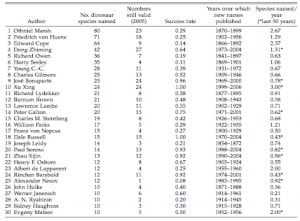Who named most new dinosaur species?
Some dinosaur workers have been more enthusiastic about naming new species than others. Who were these prolific namers of new species, who are the present top performers, and how successful have they been in establishing species that are still regarded as valid?
There have clearly been a number of famous historical dinosaur namers, including Edward Cope (1840- 1897) and Othniel Marsh (1831-1899) who dominated the famous ‘dinosaur bone wars’ of the late nineteenth century. These two named 144 species of dinosaurs between them, and in 1900 they were responsible for a full 40% of all the 359 species named to that date. Now, with a further century of study, the proportion of the total represented by their names has fallen to 10% (144 out of 1401 species).
 [Left] The famous dinosaur warriors of the late nineteenth century, Othniel Marsh (left) and Edward Cope (right).
[Left] The famous dinosaur warriors of the late nineteenth century, Othniel Marsh (left) and Edward Cope (right).
Marsh and Cope were unusually prolific in naming new dinosaurs, but they did not dominate the field as remarkably as for other groups of organisms. Gaston & Mound (1993) note that just four workers were responsible almost half the 6112 species of Thysanoptera (thrips) named from 1901 to 1993, and one of these four authors was responsible for 1065 names in his lifetime.
 [Right] Friedrich von Huene, second most prolific dinosaur namer”
[Right] Friedrich von Huene, second most prolific dinosaur namer”
The three top namers of dinosaurs are then Othniel Marsh, with 80 species, Freidrich von Huene, with 71 species, and Edward Cope, with 64 species. Marsh and Cope are well enough known – and it is ironic that Marsh was able to beat his rival even in this. (Marsh was richer than Cope, he outlived Cope, and was able to write the obituaries of his rival). But von Huene is perhaps less well known. Friedrich on Huene (1875-1969) was enormously long-lived, and published papers on dinosaurs from all continents through his long professional career, from 1897 to 1966.
These three dinosaur experts named over 200 species together. But what about the other prolific namers of new dinosaurs. Thirty such experts may be identified (Table below), each responsible for more than ten species names. Marsh, von Huene, and Cope stand out as having named very many more new species of dinosaurs (64-80 each) than the remaining workers (10-42 each). These leading thirty active namers are responsible for 717 of the 1401 named species, so just over half (51.2%). Globally, 308 of their 717 new species (43%) are still regarded as valid.

Success rate
The ‘success rate’ of a taxonomist who names new species might be defined as the proportion of their species that have survived scrutiny. In other words, how many of the dinosaurs named by Marsh, von Huene, Cope, and the other prolific namers do we still accept as valid?
Values for the success rate of prolific dinosaur namers range from 8% (Alexander Nesov) to 100% (Yu Xing and Dale Russell), with every gradation in between (Table above). The success rate is not related to the total numbers of new species erected (although the top three – Marsh, von Huene and Cope – all score less than 50%), but it is related broadly to the time when these palaeontologists worked. However, it is not clear whether the low success rates of the nineteenth century workers simply reflect the passage of time: subsequent workers have had much more time to reject their species than those named in the last ten or twenty years. Note here that there is some suggestive evidence, however, that modern workers do the job better than earlier workers.
In a further analysis (Benton 2010), it turns out that the mismatch in success rates for prolific and non-prolific dinosaur namers is more startling than might have been thought. Comparing the two categories, prolific and non-prolific, the definition of ‘prolific’ goes right down to people who named only two dinosaurian species. In other words, it’s best to name just one species of dinosaur and stop there: any more, and you pass into the ‘prolific’ category, and the success rate of dinosaur species names established by prolific drops significantly, statistically speaking.
 Dong Zhiming, leading Chinese dinosaur expert |
José Bonaparte, leading Argentinian dinosaur expert |
 Xu Xing, leading Chinese dinosaur expert |
There is no evidence for a reduction in the enthusiasm of modern dinosaur paleontologists: three of the top ten (images above), and eight of the top 30, prolific namers are still alive. As expected, their success rates (mean, 77%) are better than those of the authors active before 1950 (mean, 35%). Overall, the 30 most prolific namers of new dinosaur species have a success rate of 43%, which is slightly lower than the overall success rate of all dinosaur namers put together (48%). Perhaps the earlier highly prolific namers of new species were a little more enthusiastic in inventing new species names than they might have been!
Read more about the study
- Error in naming dinosaurs
- Naming organisms and biodiversity
- Naming and revision
- The dinosaur discovery curve
- (With all the money in the world) How to find new dinosaurs
- Who named most dinosaurs?
- Are we getting any better at it?
- Home – dinosaur names, error, and biodiversity
References
- Benton, M. J. 2008a. Fossil quality and naming dinosaurs. Biology Letters 4, 729-732. pdf.
- Benton, M. J. 2008b. How to find a dinosaur, and the role of synonymy in biodiversity studies. Paleobiology 34, 516-533. pdf.
- Benton, M.J. 2010. Naming dinosaur species: the performance of prolific authors. Journal of Vertebrate Paleontology 30, 1478-1485. pdf.
- Gaston, K. J. & Mound, L. A. 1993. Taxonomy, hypothesis-testing and the biodiversity crisis. Proceedings of the Royal Society of London, B 251, 139-142. (doi:10.1098/rspb.1993.0020)
- Weishampel, D. B., P. Dodson, and H. Osmólska, eds. 2004. Dinosauria, 2nd ed. University of California Press, Berkeley.


